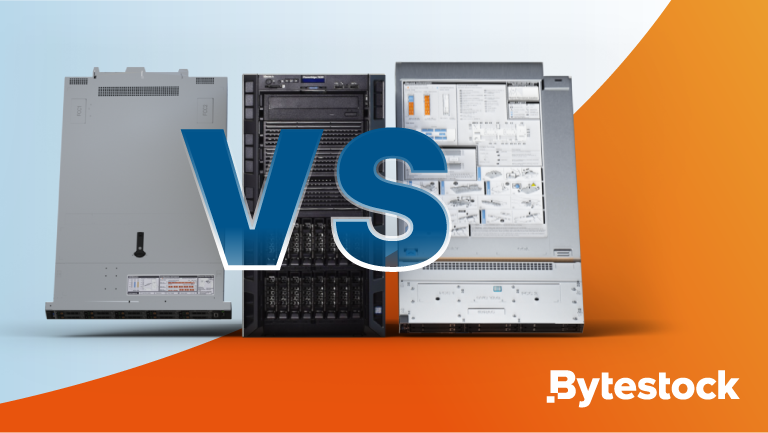A server or server network makes sharing information between locations and colleagues incredibly...
Choosing the Right Server: Rack, Blade, or Tower?

When deciding on which server to invest in, factors like space, performance, scalability, budget, and initial specifications are crucial. This blog will help you understand the advantages and limitations of rack, blade, and tower servers, so you can determine which type best fits your requirements.
Rack Servers
Rack servers are standardised units, measured in "U's" (1.75 inches tall and 19 inches wide), and are mounted inside racks that can reach up to 10 feet in height. This configuration maximises floor space in office server rooms and data centres. Rack servers are general-purpose machines that support a broad range of applications and computing infrastructure.
Pros:
- Space-efficient: Ideal for making the most of available floor space.
- Versatile: Suitable for a wide range of applications and can function as stand-alone or networked systems.
Cons:
- Cooling and Energy: Densely populated racks require more cooling units, increasing energy costs.
- Maintenance: Higher density means more troubleshooting and management time.
Blade Servers
Blade servers consist of server enclosures that hold multiple modular circuit boards, or server blades. These stripped-down units typically include CPUs, network controllers, memory, and sometimes storage drives, while other components are provided by the server chassis. Blade servers offer high processing power and can scale to meet performance needs, provided the data centre can support the necessary cooling and energy.
Pros:
- Shared Components: Switches, ports, and power connectors are shared through the chassis, reducing energy consumption.
- Space-saving: High processing power in a minimal space, suitable for hosting primary operating systems, applications, databases, and web services.
Cons:
- Initial Costs: High capital, deployment, and configuration costs.
- Climate Control: Requires advanced heating, cooling, and ventilation systems to maintain performance.
Tower Servers
Tower servers come in a stand-alone chassis configuration with minimal components and software, allowing for heavy customisation to meet specific needs. They can be adapted into general-purpose, communication, web, or network servers.
Pros:
- Customisable: IT departments can customise and upgrade them based on business needs.
- Cost-efficient: Less expensive to buy and cool compared to dense rack servers.
Cons:
- High-end Hardware Costs: Customising with high-end components can raise the price significantly.
- Maintenance: Requires opening the enclosure for troubleshooting and upgrades.
Choosing the Right Server for Your Needs
When choosing between rack, blade, and tower servers, consider the footprint and architecture that best suits your computing needs and data centre build. Each type offers high performance, but the right choice depends on your specific requirements for space, scalability, and budget.
Explore Your Options with Bytestock
Bytestock offers a vast range of refurbished Dell and HP rack, blade, and tower servers. Check out our full range and configure your ideal server system today. For more personalised advice, speak to one of our experienced team members.
By understanding your needs and the unique features of each server type, you can make an informed decision that ensures your business operates efficiently and effectively.





